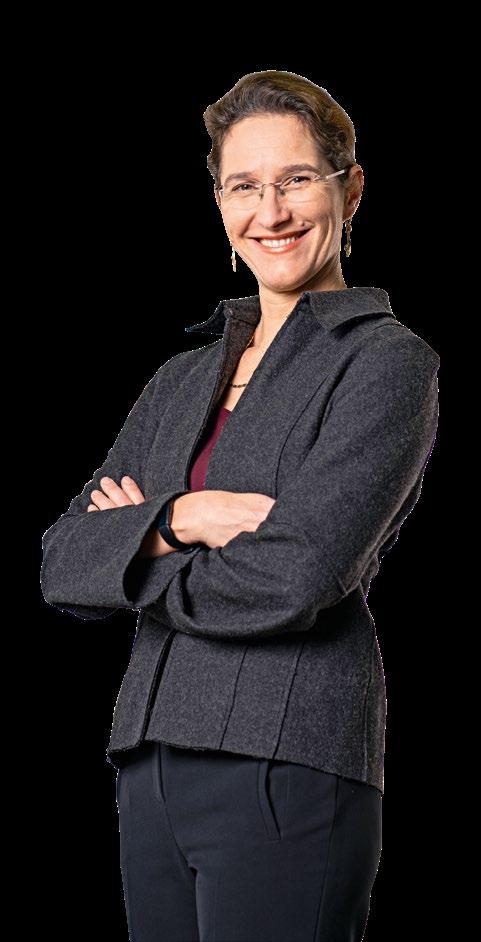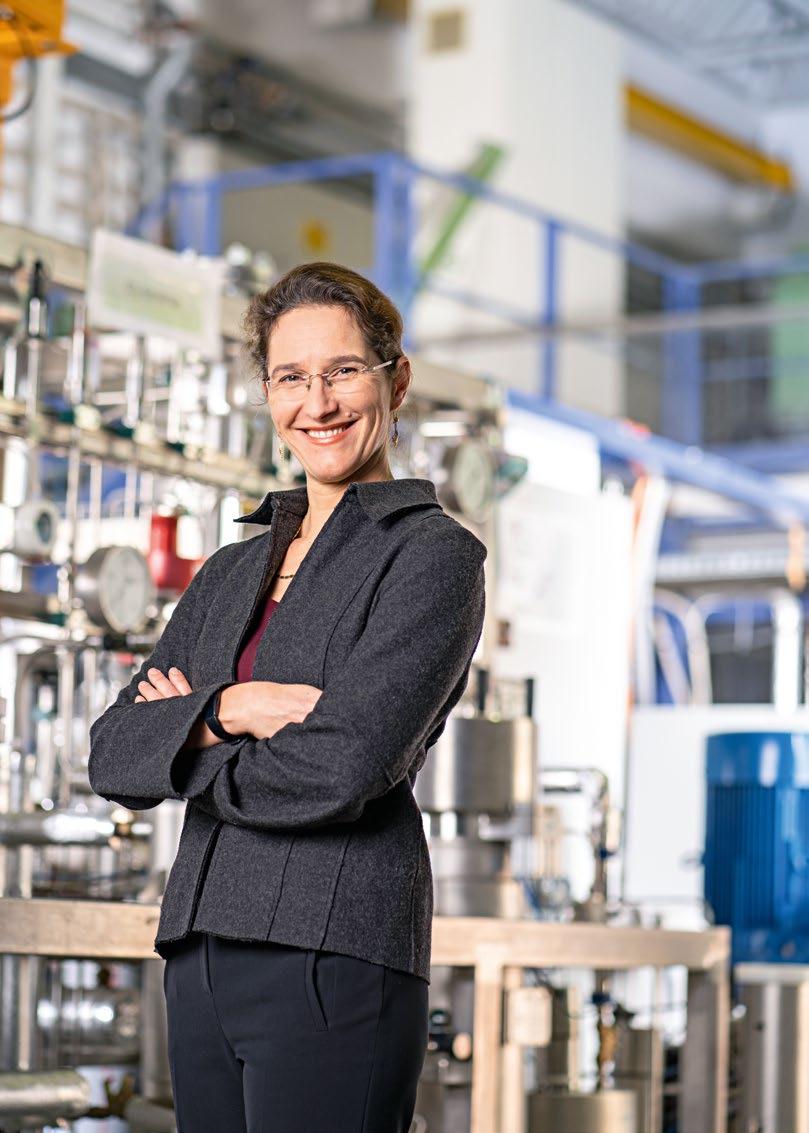
11 minute read
Dr. Christian Schemer, Professor of Communication at the Institute of Communication in Mainz, Germany, knows how language determines our perception of reality. Dr. Caroline Beier, Chairwoman of the German Synesthesia Society, explains how synesthetes perceive the world. Aroma and smell researcher Professor Dr. Andrea Büttner uses the sense of smell to “sniff out” harmful substances in products
Professor Schemer – what role does language play in terms of how we act?
Language is very important in how we form and convey the ideas, opinions, and values that shape our actions. We depict issues in a certain interpretative framework by means of the words we choose to use. It is through these frames that we communicate our views and interpret the statements of others.
Advertisement
Can you give us an example?
Let’s take the debate on abortion in the US, where proponents and opponents consciously use contro-versial terms in their activism. While proponents say the word “fetus” – the medically correct term – opponents use “baby” to stir up emotions. “Baby” makes us think of a newborn with a personality. A “fetus” is much more abstract and featureless. Here, the choice of words alone is an attempt to depict abortion as either murder or a medical procedure. Both camps try to gain the high ground by means of these frames.
Is language really that powerful?
Framing has been researched since the 1970s. And it’s been clearly proven that people who exhibit stable attitudes for or against an issue cannot be influenced by aggressive framing. On the contrary, their attitudes consolidate, and fronts become more impenetrable. To stick with this example: the choice of words won’t make opponents of abortion into proponents, and vice versa. Framing tends to have an effect on people who do not yet have a clear opinion on an issue, or when an issue is totally new to a society and people have to take a position on it. Frames can take hold where information and interpretations are sorely lacking. Interest groups also attempt to utilize this in pushing forward their ideas and in the language they use. But that only succeeds – if at all – when no strong antagonistic positions are present.
Nevertheless, framing is important in our everyday communication. Why is that?
Generally speaking, framing is a constant in our perception. It makes sense of things. After all, we want to understand what an issue is really about, and what it means for us personally. Each individual forms their own interpretative framework, depending on how an issue relates to their values. Framing allows us to allocate people to groups, categories, and ideologies. This makes the world easier to understand. This is also necessary because we are not able to understand everything going on around us in its full complexity. Our personal frame – our own worldview – helps us to efficiently make decisions. Companies of course actively use this effect. Advertising specifically depicts products in a certain context. Everything is currently organic, sustainable, and allergenfree, for example – because these are terms to which consumers react positively. The fact that this wording is often far-fetched or inaccurate on closer inspection is of secondary importance when it comes to advertising. Companies just want to touch on specific frames.
Are we able to alter our frames?
We use certain expressions as a matter of course. This isn’t an issue until conventions change or societal groups protest at their usage. One example would be gendered pronouns – we have moved on from using purely masculine pronouns, to including the female form, right through to factoring in a range of diverse genders. That means that new linguistic tendencies are constantly being evolved and adopted.
What role does language play on social media?
Generally speaking, social media allows verbal conflicts to be dragged out. A variety of conflicting opinions are disclosed online, and every statement provokes discussion, commentary, and agitation. And words are what hold true on the Internet. Even if you delete a tweet or video, copies will end up doing the rounds later on. That gives words weight. But a lot of these things tend to play out in smaller social media bubbles. Issues reach a boiling point and are then quickly forgotten again. That means that not all that’s said and written on the Internet remains relevant to or has an effect on a society – unless influential interest groups and politicians continue to push ahead with an issue. Framing is used time and time again to put issues and interpretations thereof on the societal agenda. That’s OK – that’s freedom of speech. But it’s good that increasing numbers of people are reflecting on their perception and scrutinizing language, asking themselves: “Why exactly have these words been chosen? What is the intention here?”.
Incredibly normal
SYNESTHETES HAVE A UNIQUE PERCEPTION OF THE WORLD: FIGURES, LETTERS, SOUNDS, AND SMELLS ARE CONNECTED WITH COLORS AND SHAPES. ABOUT FOUR PERCENT OF PEOPLE HAVE THIS GIFT. DR. CAROLINE BEIER, CHAIR OF THE GERMAN SYNESTHESIA ASSOCIATION, IS HAPPY TO BE ONE OF THEM.
Dr. Beier first realized that she perceived the world differently to most people when she was 17 years old: “I always associated numbers and letters with specific colors. But when I asked my classmates what it was like for them, they stared at me as if I were mad. That’s how I learned I was a synesthete.” Today Dr. Caroline Beier is a family doctor with a practice in Hamburg and Chair of the German Synesthesia Association. “It’s estimated that four percent of the population experiences synesthesia. It’s probably even more than that, because many people don’t even know that they have a special kind of sensory perception,” says Dr. Beier.
A RICH, COLORFUL INNER WORLD
Different sensory stimuli are linked with one another in an unusual way in the brains of synesthetes – for example, when they see something it is accompanied by a noise or taste. Sounds and melodies make colorful, static, and moving shapes appear inside their mind's eye or even outside of their bodies. “Colorful hearing” is also quite common. “Everything I read, hear, and think automatically creates colors in my mind,” explains Caroline Beier. Words and letters have a specific color for many synesthetes, but for Dr. Caroline Beier it’s only vowels. For instance U is kind of green, while E is brown. Her synesthesia also applies to her sense of touch. “I very intensively perceive my patients through their speech and demeanor, but also through my hands. During physical examinations I can quickly tell where the issue lies.” Her gift even helped Dr. Beier during her studies. Like a lot of synesthetes, she is better able to remember formulae, names, and other pieces of data thanks to her extra layer of sensory perception – mnemonics that others spend hours making up are something that synesthetes automatically put together. Many are also creative. Famous examples include artists like the singer Lady Gaga, the painter Wassily Kandinsky, and the writer Vladimir Nabokov. Yet research on this neural phenomenon is still in its early stages. One hypothesis claims that all newborns are synesthetes and that we more or less lose this characteristic as our growing brains differentiate. However, it is much more likely that synesthesia is passed down genetically. Brain scans have shown that sensory perception in synesthetes activates more areas of the brain than in non-synesthetes. This doesn’t revolve around the individual subconsciously feeling, but consciously experiencing instead. Synesthetic sensory perception is inseparable from our “usual” sensory impressions, and similarly, it is not possible to fully block them out. Synesthetes tend to view their pronounced sensitivity as a gift, says Dr. Caroline Beier: “This inner colorful world, sensitivity, and an ability to empathize are enriching, not to mention wonderful, indispensable parts of our personalities.”

Dr. Caroline Beier is a family doctor and Chair of the German Synesthesia Association (www. synaesthesie.org). This association connects people who have synesthesia, follows research on this neurobiological phenomenon, and makes these studies known to the public.


Professor Andrea Büttner is a food analyst and Chair of Aroma and Smell Research at Friedrich Alexander University Erlangen-Nürnberg. Since 2020, the internationally renowned scientist has also been director of the Fraunhofer Institute for Process Engineering and Packaging in Freising. She is not just passionate about sensory perception, but also about developing new foodstuffs, protecting the environment, and sustainable economic activity in a globalized world.
Always follow your nose
WE TAKE JUST ONE SIP OF MILK, AND WE NOTICE IF IT IS SPOILED. PROFESSOR DR. ANDREA BÜTTNER IS CURRENTLY INVESTIGATING HOW WE CAN TRANSMIT OUR OLFACTORY SENSES OF SMELL AND TASTE TO TECHNICAL SYSTEMS. HER GOAL IS TO TRACK DOWN HAZARDOUS SUBSTANCES IN PRODUCTS AT THE EARLIEST STAGE POSSIBLE.
Professor Büttner – what do you find so fascinating about our senses of smell and taste?
Our chemical senses are our most ancient senses, evolutionarily speaking. Even single-cell organisms make contact with their environment via chemical sensory systems. Our senses of smell and taste provide us with an incredible amount of information about a whole range of different molecules and fulfill several elementary biological roles. They protect us from hazards by enabling us to detect smoke or help us subconsciously in selecting our sexual partners, for example.
Dogs sniff out drugs, rats can detect tuberculosis – how does the human nose compare?
We are not particularly attuned to our sense of smell – we are more fixated on our hearing, and on our sight especially. But our nose is extremely sensitive and can even be trained – take a look at sommeliers, for example. In evolutionary terms, we’re omnivores. This explains why we are able to perceive a very wide spectrum of smells and substances. However, it is estimated that about 15 percent of adults have a greatly impaired sense of smell or no sense of smell at all. It’s when you can’t smell whether food has gone off or not that you have a problem.
If you have poor eyesight, you wear glasses. Hearing aids help the hearing-impaired. Has anything comparable been developed for our sense of smell?
Not yet. That’s because molecules that we perceive as having an odor are often present in very low concentrations and are upstaged by other non-odorous substances. This makes direct measurements using machines a challenge. One trick can be to discover a characteristic pattern that doesn’t necessarily relate to the odorous substances, but correlates with a sensory impression. However, many interfering influences can pop up. For example, if you want to diagnose an illness like cancer with a breath sample, then the patient’s last meal could falsify the result. However, it would help us if we had systems that warned us about potential risks or illnesses so that we could take a closer look. What’s more, we are often better able to reliably detect toxic emissions or contamination because they smell so strong.
What use would this have specifically?
If the smell of a plastic toy seems strange and lingers in our noses, then this serves as a warning signal. Mechanical noses could take on the task of detecting anomalies and sounding the alarm. These would sniff out things that human beings cannot or should not smell to eliminate hazards. Where possible, this would happen before harmful substances and products went into circulation. Sensory quality control should become an integral part of production facilities and logistics centers within networked systems that immediately warn the responsible bodies. This would be a massive step forward for consumer protection as when we look at the globalized market, product safety and monitoring is reaching its limits.
How so?
New and unknown harmful substances are always coming into circulation. These have to be tracked down at the earliest stage possible. We don’t just want to protect children from plasticizers in toys. It’s also about saving resources, occupational safety, and environmental protection, not to mention protecting the people who have to handle raw materials and products on a daily basis in factories, warehouses, and stores. Sensory diagnostics of harmful substances could help to keep substances that are harmful to human health and the environment off the market. That is why many quality-oriented companies want to collaborate with us.
I suppose that means that until this technology has evolved, we’ll simply have to continue relying on our noses?
This ancient sense helps us to detect harmful things in the modern world. But it would be better if we didn’t need to completely rely on our noses. Machines have to help us, and making that happen is our job.
Global internet coverage – from outer space!

SINCE THE BEGINNING OF 2019, THE COMPANIES SPACEX AND ONEWEB HAVE BEEN SHOOTING SATELLITES INTO THE EARTH’S ORBIT IN ORDER TO PROVIDE EVEN THE MOST FAR-FLUNG CORNERS OF THE WORLD WITH HIGH-SPEED INTERNET. THESE REVOLUTIONARY PROJECTS OFFER A WIDE ARRAY OF OPPORTUNITIES – YET ALSO POSE DIRE CONSEQUENCES.






